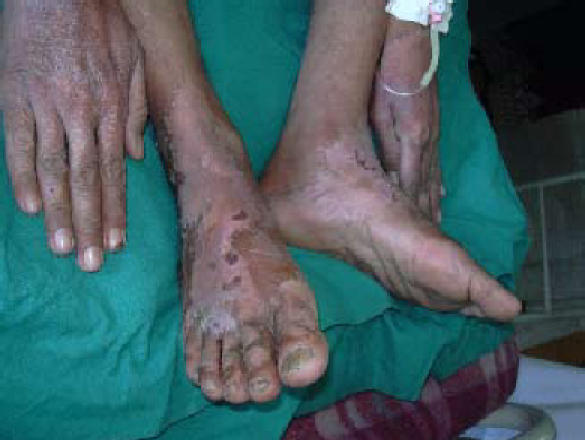Editor,
Pellagra, described by Casal in 1735, is endemic in Africa and Asia where staple food is nicotinic acid deficient corn-based diet and related to poverty among refugees or displaced people.1 It is infrequently seen in developed countries in chronic alcoholics or rarely in anorexia nervosa.
Case History: A 57 year-old chronic smoker and alcoholic, suffering from pulmonary Koch's and peeling dermatitis, had presented with confusion, involuntary flinging of legs and irresistible grasping of hands. Bladder-bowel functions were normal. Besides pallor, beefy tongue and polymorphic ronchi, physical examination was unremarkable. Neurological examination revealed rigidity and weakness in all four limbs, brisk reflexes, bilateral up-going planters, positive sucking and grasp reflex. Dermatological examination showed peeling dermatitis with erythema and pigmentation (Fig 1). Medication consisted of asthalin, rifampicin, isoniazide, pyrazinamide, ethambutol and multivitamin. Except 9.8gm% haemoglobin, routine plasma glucose, electrolytes, renal and liver function tests were normal. Chest x-ray and abdominal ultrasound showed emphysematous lungs and hyperechoic 16cm fatty liver. Computerized tomography of brain was normal.
Figure 1.

Peeling dermatitis of pellagra
Discussion
Antitubercular drug induced pellagra encephalopathy has never been described in the literature as opposed to that caused by chronic alcoholism and diarrhoea. We presenting an interesting case of full blown pellagra with cutaneous and neuro-psychiatric manifestations possibly caused by isoniazid-pyrazinamide and alcohol, treated with intravenous niacin leading to a dramatic recovery. Nicotinic acid dinucleotide and nicotinic acid dinucleotide phosphate, derived from dietary tryptophan, are essential co-enzymes in metabolism of intestinal, epidermal and more electronsensitive neuronal cells. Pellagra is common in raw-spirit drinkers of rural populations in the Third World whose staple diet is niacin deficient jawar or maize with inadequate animal protein, fruits and vegetables. Secondary deficiency of niacin occurs in malabsorption and carcinoid syndrome, cirrhosis of liver and Hartnup disease. Prolonged therapy with pyrazinamide, isoniazide, 6-mercaptopurine and 5-flurouracil may also result in pellagra like syndromes. Pyrazinamide and isonicotinic acid hydrazide (INH) are structural analogues of niacin and can depress endogenous niacin production by feedback inhibition or substrate competition. INH impairs the functioning of pyridoxine, a cofactor in tryptophan-niacin pathway and inhibits the niacin synthesis leading to pellagra.2 Dermal pathogenesis reveals lowered collagen and urocanic acid content, serving as a filter for ultraviolet radiation, may cause photosensitive pellagra dermatitis. Chromatolytic changes are found in Betz cells of motor cortex. Similar cerebellar changes, optic neuropathy and cerebral deficit seen in pellagra encephalopathy may not resolve completely even with high doses of niacin. The diagnosis of pellagra is clinical. Laboratory diagnosis by fluorometric assay of urinary metabolites (2-pyridone/ N-methylniacinamide ratio less than 2.0) is not unequivocal evidence of pellagra. The recommended daily allowance is 10-20mg/day. Since niacin causes flushing, headache, burning and tingling sensations, niacinamide is prescribed orally (300-500 mg) and parenterally (100 mg per day) in divided doses. Neuropsychiatric manifestations are relieved dramatically overnight. Topically zinc oxide and para-aminobenzoic acid ointment may be advised.
Conclusion
Physicians should be aware of such cases and should treat any ”sick“ person with unexplained skin, neuro-psychiatric changes or gastrointestinal complaints with safe, inexpensive doses of niacin.
Acknowledgments
We are thankful to Prof PVS Rana, MD, DM (Neuro), Professor of Neurology, Manipal Teaching Hospital, Pokhara, Nepal, for his valuable guidance in preparing this manuscript.
References
- 1.Mason JB. Lessons on nutrition of displaced people. J Nutr. 2002;132(7):2096S–2103S. doi: 10.1093/jn/132.7.2096S. [DOI] [PubMed] [Google Scholar]
- 2.Jorgensen J. Pellagra probably due to pyrazinamide: development during combined chemotherapy of tuberculosis. Int J Dermatol. 1983;22(1):44–5. doi: 10.1111/j.1365-4362.1983.tb02114.x. [DOI] [PubMed] [Google Scholar]


